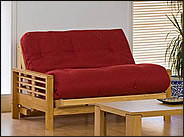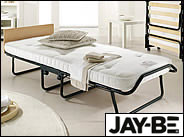Q1 : Two or Three Seat Futon Sofa Bed: Which frame do I choose?A : Our most popular futons and sofa beds are available as two or three seat wooden frames. We are often asked which is best – the simple answer is that they both have their own benefits. Perhaps the fundamental consideration is the amount of space available in your room. Our two seat futons have a 120cm width parallel to your wall, occupying less space than the bigger three seat models, opening out into the room for its bed position at a length of 185cm. They do, however, have three folding decks, making the conversion between seat and bed a more involved process. Conversely, our three seat models come with two-deck mechanism for easy conversion. Due to the size and nature of the sleeping area, they do require more wall space: At a length of 185cm parallel to the wall and 137cm width away from the it, they fold perpendicular to the frame in the style of a traditional wooden bed. In Additon, the selection of a three seat frame will allow a Supreme grade mattress to be used, which provides a better sleeping surface. Q2 : Which Futon mattress thickness should I choose?A : We offer a total of three mattress grades for your futon. With some limited to specific frames, as laid out on our product pages, this can help to narrow your decision down. The most important consideration when choosing your futon mattress is that the deeper it is, the more comfortable it will be. Standard Futon Mattresses.
Available across a wide range of models. At a depth of 12.5cm, these products set the industry standard and are often sold by large retail chains. Deluxe Futon Mattresses.
Our most common mattress choice for two-seat futon sofa beds. Deeper than Standard mattresses, at a thickness of 15cm our Deluxe range offers greater comfort and is available for all but our most basic two and three seat models. Supreme Futon Mattresses.
The most popular choice for use with our three-seat, wooden-framed futon sofa beds. With a depth of 18cm, our Supreme mattresses give superior comfort and a buoyant surface for you and your guests to sleep on. Q3 : Which Futon cover material should I choose? A : At Futon Sofa Beds Direct, we offer two grades of fabric to cover your futon sofa bed mattress – Basic and Premium. The Basic grade futon covers are made from 100% natural cotton. Though limiting your choice of design and mattress density, the cotton drill is more breathable and available in a variety of colours. Premium grade fabrics are made from a more durable materials such as polyester and Viscoe, allowing for a denser and more textural finish. Q4 : Delivery: How we do it and what can you expectA : We offer 2 main types of delivery. Single Man Service:
We use a single man van service as standard to deliver our futon products. Our carriers offer kerb side delivery which includes your buildings ground floor entrance (if you live in a flat or apartment). Transportation beyond this point is at the discretion of the driver. When your product is ready, we will contact you by telephone to arrange a date for delivery: A working day service as standard, with a variety of optional upgrades - weekday AM, ‘By 10am’, Saturday, and ‘Two Man Room of Choice’. Two Man Service:
This service is standard on our fully assembled sofa beds and is available as an upgrade for our futon products; our two-man service allows for room of choice delivery. We will contact you when your product is ready for dispatch and arrange a mutually agreed delivery date, available through our carrier’s website. This service offers ‘room of choice’ delivery: Provided there is sufficient access to the property, with low damage risk to the product and your home, the delivery team will take it to whichever room you choose. Q5 : Frequency of Use?A : It is important that during frequent use for sleep, your mattress be comfortable and supportive. Though comfort and support will be subject to each person’s opinion, within our industry it is expected that for regular use, you should have the support of a quality sprung mattress. While many customers have slept on futons for long time periods, because of industry recommendations, we categorise our ranges as ‘Occasional Sleepers’; for infrequent use. Q6 : Can I clean my futon sofa bed mattress?A : We receive a lot of emails and telephone queries asking whether futons can be cleaned, or the covers remove to be washed. In order to meet BS 4875, our futons and covers are treated with a fire-retardant material which is water soluble. As such, we advise against washing unless cleaned by a professional who can ensure that the fire-retardant will not be compromised. Much like your bed, a futon cannot be machine-washed or dry-cleaned – in the event of spillage, blot it up quickly with an absorbent cloth or tissue. Regular vacuuming using an upholstery attachment can also help to remove dust, dirt and debris from your futon mattress. Q7 : How comfortable are futons? A : This is difficult to answer because there is no universal scale against which each futon can be compared. Our mattresses are filled with Wool Dub, a soft material that may not be suited to those who prefer a harder sleeping surface. Our mattresses are made to fit the frames designed by our suppliers, and over the course of our decade in the business, we have had few complaints regarding comfort. Q8 : What Aftercare and Maintenance is required?A : At Futon Sofa Beds Direct we are often asked about aftercare for our futons. It is important to keep your futon mattress dry and clean – we recommend placing a good quality washable mattress protector over your mattress for night time use. It is a good idea to turn the mattress regularly to ensure even wear – ALWAYS USE TWO PEOPLE TO LIFT THE MATTRESS. If it is used more frequently as a seating area, then this will naturally cause more wear. If used permanently as a sleeping area, the mattress can begin to wear unevenly. Every few months, turn your mattress top to bottom and from foot to head. Hold the entire mattress so that the cover does not tear, as well as preventing hollows or lumping. With its origins in Japan, the futon began as a lighter-weight, roll-up floor ‘mattress’ which could be aired easily; either draped over balconies or hung from washing lines. With their heavier, deeper-set mattresses, our ‘Western’ style futons would be difficult to air outside. British weather permitting of course, you can put your futon outside, allowing any accumulated moisture to dry out and help in maintaining the loft of the fibres. In colder, damp conditions it is important to check for soiling or moisture which may condense on the underside of your futon. To combat this, simply turn and air your mattress more frequently. Additional covers are dry-clean only – they can bring your old futon back to life and are easy to put on and take off; simply zip them into place. Our large range of replacement covers can offer you a stylish new look for a fraction of the price! Q9 : What's the difference between a Traditional and Western Futon? A : Derived originally from Japan, futon mattresses now come in two variations Traditional Futons
With its origins in Japan, the futon began as a lighter-weight, roll-up floor ‘mattress’ which could be aired easily; either draped over balconies or hung from washing lines. With their heavier, deeper-set mattresses, our ‘Western’ style futons would be difficult to air outside. British weather permitting of course, you can put your futon outside, allowing any accumulated moisture to dry out and help in maintaining the loft of the fibres. In colder, damp conditions it is important to check for soiling or moisture which may condense on the underside of your futon. To combat this, simply turn and air your mattress more frequently. Western:
The Western futon first appeared as a carbon copy of the Japanese product. Shortly afterward, designers began to play around with the make-up of the mattress: Adding extra layers of filling to increase comfort, the product rose to the standards demanded by the western market, the only drawback being its decreased discretion and portability. Over the last several decades, the ‘futon sofa’ concept has become a staple addition to many home furniture suites, with the versatility of a daytime seating area and sleep conversion. For a time, quality futon mattresses were sold by layer; four layers up to eight, for example. Without regulatory standards however, the manufacture would subjectively decide on the thickness of the layer and materials used, often confusing customers and leaving many disappointed. Now moving away from that system, talk has begun to turn to the quality of the filling. |







